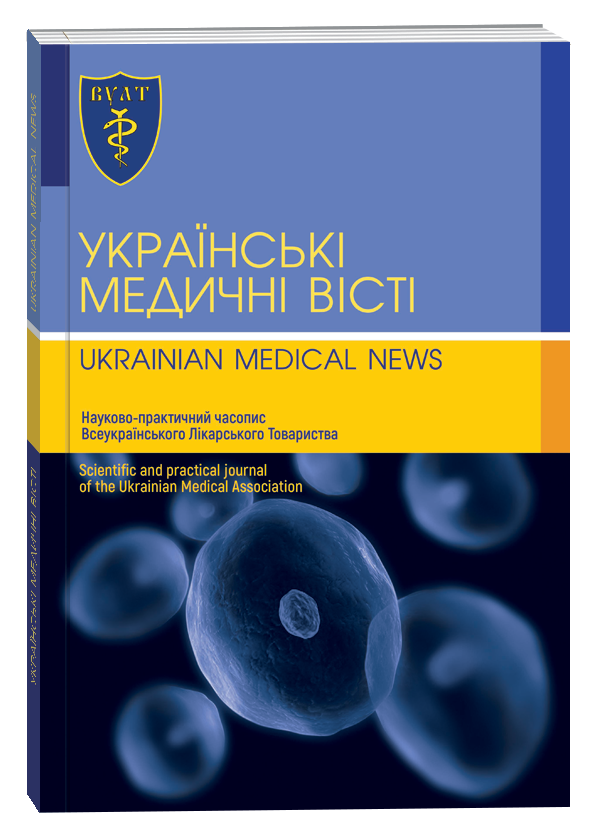DIGEST OF THE 62 ANNUAL MEETING OF THE EUROPEAN SOCIETY OF PEDIATRIC ENDOCRINOLOGY: ORPHAN DISEASES
DOI:
https://doi.org/10.32782/umv-2025.1.5Keywords:
rare diseases, orphan diseases, personalized treatment, European Society of Pediatric EndocrinologyAbstract
Genetic discoveries have significantly improved our understanding of the mechanisms responsible for a cluster of rare diseases associated with endocrine disruption and have contributed to the development of new preventive and therapeutic strategies. Medical innovation is increasingly focusing on providing care based on individual patterns of genetic predisposition. At the end of 2024, the 62nd Annual Meeting of the European Society of Pediatric Endocrinology was held in Liverpool, UK, from 16 to 18 November. One of the main slogans of the event was to put the management of rare diseases associated with endocrine disruption into action. ESPE 2024 was an unparalleled opportunity to network and share invaluable knowledge with hundreds of stakeholders in the rare endocrine disease community. Special attention at the plenary lectures of this event was devoted to the genomics of rare diseases, at the symposia – to highlighting the latest information on growth disorders, mineral disorders, promising methods of treating skeletal diseases, sexual development, the presentation of the Andersen Award for research on the FDX1 missense mutation, which causes congenital adrenal hyperplasia with 11β-hydroxylase deficiency and vitamin D-resistant bone rickets, as well as the presentation of a description of a new human disorder – short stature caused by QSOX2 deficiency, impaired gastrointestinal motility, and immune dysfunction.
References
1. Oberfield S.E., Rogol A.D., Miller W.L. A brief history of the Pediatric Endocrine Society (PES). Horm Res Paediatr. 2022. № 95 (6). P. 510–4. DOI: 10.1159/000526439.
2. Про внесення змін до основ законодавства України про охорону здоров’я щодо забезпечення профілактики та лікування рідкісних (орфанних) захворювань : Закон України від 15.04.2014 р. № 1213–VII. URL: https://zakon.rada.gov.ua/laws/show/1213-18#Text.
3. Про внесення змін до Переліку референтних центрів з питань рідкісних (орфанних) захворювань : наказ МОЗ України від 21.05.2024 р. № 864. URL: https://moz.gov.ua/uk/decrees/nakaz-moz-ukraini-vid-21052024--864-pro-vnesennja-zmin-do-pereliku-referentnih-centriv-z-pitan-ridkisnih-orfannih-zahvorjuvan.
4. Korf B.R. Recognizing those who deal with rare disease every day. Am J Hum Genet. 2021. № 108 (2). P. 213. DOI: 10.1016/j.ajhg.2021.01.005.
5. Антипкін Ю.Г., Волосовець О.П. Забруднення повітря та стан здоров’я дитячого населення України. Ukrainian Journal of Perinatology and Pediatrics. 2020. № 3 (83). P. 31–39. DOI: 10.15574/PP.2020.83.31.
6. Про затвердження переліку рідкісних (орфанних) захворювань : наказ МОЗ України від 27.10.2014 р. № 778. URL: http://www.moz.gov.ua/ua/portal/dn_20141027_0778.html.
7. Savage M.O., Donaldson M.D.C., Davies J.H., Storr H.L. Key Stages in the Development and Establishment of Paediatric Endocrinology: A Template for Future Progress. Horm Res Paediatr. 2024. № 97 (1). P. 22–27. DOI: 10.1159/000530841.
8. Абатуров О.Є., Нікуліна А.О. Європейська конференція з рідкісних захворювань та орфанних препаратів 2022: місія можлива. Українські медичні вісті. 2023. Т. 15. № 1 (94). P. 5–9. DOI: 10.32782/umv-2023.1.1.
9. Nguengang Wakap S., Lambert D.M., Olry A., et al. Estimating cumulative point prevalence of rare diseases: analysis of the Orphanet database. Eur J Hum Genet. 2020. № 28 (2). P. 165–173. DOI: 10.1038/s41431-019-0508-0.
10. Chung C.C.Y., Hong Kong Genome Project, Chu A.T.W., Chung B.H.Y. Rare disease emerging as a global public health priority. Front Public Health. 2022. № 10. P. 1028545. DOI: 10.3389/fpubh.2022.1028545.
11. Nikulina A. Significance of single-nucleotide variants of anorexigenic hormone genes in childhood obesity. Medicni perspektivi. 2024. № 29 (1). P. 108–114. DOI: 10.26641/2307-0404.2024.1.300508.
12. Kim J.H., Choi J.H. Applications of genomic research in pediatric endocrine diseases. Clin Exp Paediatr. 2023 Dec. № 66 (12). P. 520–530. DOI: 10.3345/cep.2022.00948.
13. Sävendahl L., Witchel S. Controversy: Should we restrict height in tall stature? ESPE Abstracts. 2024. 98 CON1. DOI: 10.1159/000541189.
14. Holmgren A., Niklasson A., Gelander L. Analysis of growth patterns in Klinefelter syndrome using the QEPS growth model. ESPE Abstracts. 2024. 98 RFC 5.4. DOI: 10.1159/000541189.
15. Yuen K.C.J., Biller B.M.K., Radovick S., et al. American association of clinical endocrinologists and American college of endocrinology guidelines for management of growth hormone deficiency in adults and patients transitioning from pediatric to adult care. Endocr Pract. 2019. № 25 (11). P. 1191–1232. DOI: 10.4158/GL-2019-0405.
16. Grimberg А. Guidelines for Growth Hormone and Insulin-Like Growth Factor-I Treatment in Children and Adolescents: Growth Hormone Deficiency, Idiopath and Primary Insulin-Like Growth Factor-I Deficiency. Hormone Research in Paediatr. 2016. № 86. P. 361–397. DOI: 10.1159/000452150.
17. Savage M.O., Storr H.L. The balanced assessment of growth disorders using clinical, endocrinological and genetic approaches. Ann Paediatr. Endocrinol Metab. 2021. № 26 (4). P. 218–26. DOI: 10.6065/apem.2142208.104.
18. Pinnaro C.T., Zimmerman B.I., Ryckman K.K., et al. The Influence of X Chromosome Parent-of-Origin on Glycemia in Individuals with Turner Syndrome. Horm Res Paediatr. Published online November 18, 2024. DOI: 10.1159/000542677.
19. Dowlut-McElroy T., Kanakatti Shankar R. Hormone Replacement Therapy after Pubertal Induction in Adolescents and Young Adults with Turner Syndrome: A Survey Study. Horm Res Paediatr. 2024. № 97 (1). P. 62–69. DOI: 10.1159/000530724.
20. Toni L., Plachy L., Dusatkova P., et al. The Genetic Landscape of Children Born Small for Gestational Age with Persistent Short Stature. Horm Res Paediatr. 2024. № 97 (1). P. 40–52. DOI: 10.1159/000530521.
21. Bober M.B., Khan N., Kaplan J., et al. Majewski osteodysplastic primordial dwarfism type II (MOPD II): expanding the vascular phenotype. Am J Med Genet A. 2010. № 152-A (4). P. 960–965. DOI: 10.1002/ajmg.a.33252.
22. Pan X., Gao Y., Guan K., Chen J., et al. Ghrelin/GHSR System in Depressive Disorder: Pathologic Roles and Therapeutic Implications. Curr Issues Mol Biol. 2024. № 46 (7). P. 7324–7338. DOI: 10.3390/cimb46070434.
23. Melmed Ch. Impact of GH on DNA Damage. ESPE Abstracts (2024) 98 PL1 ; Chesnokova V., Zonis S., Apostolou A, et al. Local non-pituitary growth hormone is induced with aging and facilitates epithelial damage. Cell Rep. 2021. № 37 (11). P. 110068. DOI: 10.1016/j.celrep.2021.110068.
24. Rao E., Weiss B., Fukami M., et al. Pseudoautosomal deletions encompassing a novel homeobox gene cause growth failure in idiopathic short stature and Turner syndrome. Nat Genet. 1997. № 16. P. 54–63.
25. Raimann A., Stepien N., Azizi A.A., et al. Accelerated Linear Growth during Erdafitinib Treatment: An FGFR-Related, but Growth Factor and Sex Steroid-Independent Mechanism? Horm Res Paediatr. Published online July 31, 2024. DOI: 10.1159/000540485.
26. Colares Neto G.P., Alves C.A.D. Desmistifying skeletal dysplasias: a practical approach for the pediatric endocrinologist. Horm Res Paediatr. Published online February 2, 2024. DOI: 10.1159/000536564.
27. Savarirayan R., Hoover-Fong J., Ozono K., et al. International consensus guidelines on the implementation and monitoring of vosoritide therapy in individuals with achondroplasia. Nat Rev Endocrinol. 2025. DOI: 10.1038/s41574-024-01074-9.
28. Wagner C.A. The basics of phosphate metabolism. Nephrol Dial Transplant. 2024. № 39 (2). P. 190–201. DOI: 10.1093/ndt/gfad188.
29. Munteanu M., Resch E., Bildheim V., et al. The Endocrine Chameleon: Expanding the phenotype of Pseudohypoparathyroidism 1A in infancy. Horm Res Paediatr. Published online January 10, 2025. DOI: 10.1159/000543167.
30. Seven Menevse T., Iwasaki Y., Yavas Abali Z., et al. Venous Thrombosis in a Pseudohypoparathyroidism Patient with a Novel GNAS Frameshift Mutation and Complete Resolution of Vascular Calcifications with Acetazolamide Treatment. Horm Res Paediatr. 2024. № 97 (4). P. 404–415. DOI: 10.1159/000534456.
31. Rizzoti К. Early postnatal pituitary stem cells mostly generate gonadotrophs. ESPE Abstracts. 2024. 98. S. 6.2. DOI: 10.1159/000541189.
32. Oleari R., Lettieri A., Amoruso F., et al. Studying the genetic interplay between GnRH deficiency and associated neurocognitive disorders by combining in silico, in vitro and in vivo tools. ESPE Abstracts. 2024. 98. S. 12.3. DOI: 10.1159/000541189.
33. Kolesinska Z., Kupinski S., Zakrzewska M., et al. Face processing patterns in individuals with gender incongruence or differences of sex development: an eye-tracking study. ESPE Abstracts. 2024. 98. P. 1–284. DOI: 10.1159/000541189.
34. Zerrin O., Busra D., Çiğdem Y.K., et al. SRY-positive 45, X male with monoorchism and hypospadias. ESPE Abstracts. 2023. 97. P. 2–180. Horm Res Paediatr. 2024. № 97. Suppl 3. P. 495. DOI: 10.1159/000541189.
35. Alexander E.C., Faruqi D., Farquhar R., et al. Gonadotropins for pubertal induction in males with hypogonadotropic hypogonadism: systematic review and meta-analysis. Eur J Endocrinol. 2024 Jan 3. № 190 (1). P. 1–11. DOI: 10.1093/ejendo/lvad166.
36. Kaiser U. MKRN3 and the initiation of puberty. ESPE Abstracts. 2024. 98. PL. 5. DOI: 10.1159/000541189.
37. Roberts S.A., Kaiser U.B. Genetics in endocrinology: Genetic etiologies of central precocious puberty and the role of imprinted genes. Eur J Endocrinol. 2020. № 183 (4). R107 – R117. DOI:10.1530/EJE-20-0103.
38. Collins B.E., Neul J.L. Rett Syndrome and MECP2 Duplication Syndrome: Disorders of MeCP2 Dosage. Neuropsychiatr Dis Treat. 2022. № 18. P. 2813–2835. DOI: 10.2147/NDT.S371483.
39. Latronico A.C. Neurodevelopmental syndromes associated with central precocious puberty. ESPE Abstracts. 2024. № 98. S. 12.2. DOI: 10.1530/EJE-20-0103.
40. Piovesan M., Baracho Macena L., de Lima Jorge A., et al. Genetic Investigation of Regulatory Regions of MKRN3 and DLK1 Genes in Children with Central Precocious Puberty. Horm Res Paediatr. Published online December 20, 2024. DOI: 10.1159/000543155.
41. Claahsen-van der Grinten H.L., Speiser P.W., Ahmed S.F., et al. Congenital Adrenal Hyperplasia-Current Insights in Pathophysiology, Diagnostics, and Management. Endocr Rev. 2022. № 43 (1). P. 91–159. DOI: 10.1210/endrev/bnab016.
42. Krone N. Lessons from CAH service evaluation and real-world data. ESPE Abstracts. 2024. № 98. S. 5.3. DOI: 10.1530/EJE-20-0103.
43. Auchus R.J., Sturgeon J., Lin V.H. Crinecerfont in Adult Congenital Adrenal Hyperplasia. Reply. N Engl J Med. 2024. № 391 (16). P. 1557–1558. DOI: 10.1056/NEJMc2411263.
44. Argente J., Dunkel L., Kaiser U.B., et al. Molecular basis of normal and pathological puberty: from basic mechanisms to clinical implications. Lancet Diabetes Endocrinol. 2023. № 11 (3). P. 203–216. DOI: 10.1016/S2213-8587(22)00339-4.
45. Frederiksen H., Johannsen T.H., Andersen S.E., et al. Sex- and age-specific reference intervals of 16 steroid metabolites quantified simultaneously by LC-MS/MS in sera from 2458 healthy subjects aged 0 to 77 years. Clin Chim Acta. 2024. № 562. P. 119852. DOI: 10.1016/j.cca.2024.119852.
46. Janot C., Lucas C., Mallet D. Biallelic missense FDX1 mutation causes congenital adrenal hyperplasia with 11β‐hydroxylase deficiency and vitamin D‐resistant bone rickets. ESPE Abstracts. 2024. № 98. HA1. DOI: 10.1530/EJE-20-0103.
47. Maharaj A., Ishida M., Rybak A., et al. Novel human disorder: QSOX2 deficiency-induced growth restriction, gastrointestinal dysmotility and immune dysfunction highlights a new mechanism of disease. ESPE Abstracts. 2024. № 98. HA2. DOI: 10.1530/EJE-20-0103.








